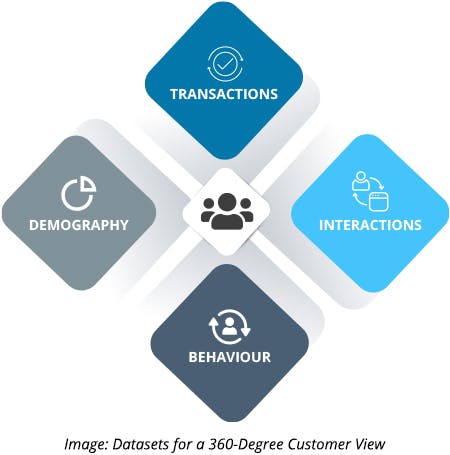In this digital era, what drives customer loyalty and relationship with an organization is the holistic experience that it provides to its consumers. To deliver an experience that is tailored to meet each customer’s need, it is imperative that organizations not only lead with content that is of value and interest but also focuses on what rhymes with the customer needs at that specific point in time.
It is a no-brainer that the companies must take a holistic approach to know their customers better. To achieve this comprehensive view of the customers, the organizations must curate a unified customer data mart incorporating all attributes (or links to these attributes in other databases) that would provide them the basis for building an analytics-driven, customer-centric digital strategy to offer wonderful customer experiences, personalized interactions, that drive retention and growth.
This blog will explore ways to create a holistic customer view (also called a 360-degree customer view), datasets needed to build this view, and business insights required to drive growth. We will conclude the blog with some typical data challenges that organizations face while they embark on this journey and our point of view on smartly tackling these challenges.
What is a 360-Degree Customer View?
A 360-degree customer view is a complete picture of a customer attained by aggregating all data attributes that are collected from multiple sources—structured and unstructured—when they “interact” with a brand. There are multiple touchpoints through which customers interact viz. making a purchase, returning a product, requesting a refund, contacting customer care, writing a product review on social media, expressing sentiments about a product, sharing the brand experience, etc. Such information could also be extended to know the customers’ future needs based on their online behavior that helps in offering relevant recommendations. Thus, the 360-degree customer view is the ability to utilize key customer information collected and curated from all relevant internal and external data sources to support strategic and operational business needs.
Why is the 360-Degree Customer View Important?
A 360-degree customer view allows the organizations to provide a better-customized experience and achieve performance objectives. Following are some benefits of having a comprehensive customer view:
- Personalization: The most recent and accurate information will help you drive better-targeted campaigns, resulting in higher conversions.
- Customer Intelligence and Segmentation: High-quality customer information would enable a brand to build accurate customer-behavior models that will enhance its ability to deliver relevant, personalized, contextual, and predictive customer experiences.
- Predictive Analytics: Improvements in customer segmentation based on the information available in data silos would help in predicting the future actions of customers and delivering better-targeted campaigns.
- Seamless Customer Experience: Regardless of the channel or touchpoint chosen by the customer, the brand could use the information to offer a consistent experience.
- Customer Lifetime Value (CLTV): Allows organizations in aligning their services to customers based on their contribution to the company. To determine the CLTV value, the company calculates a customer’s profitability and RFM (Recency, Frequency, and Monetary). The customer with high CLTV value receives a prioritized service when a problem occurs vis-a-vis a customer with low CLTV value.
- Customer Retention: Offers improvisation while running loyalty programs for loyal customers to maintain constant engagement and ensure customer retention.
Datasets for 360-Degree Customer View and Their Contribution
Let us take a quick look at key datasets that help in creating the 360-degree customer view.

Demography
This contains statistical data related to the unique identities of customers that include gender, age, marital status, billing address, and purchase intent, to name a few. While most primary customer attributes are created and stored within the enterprise via accounts, profile, and payment information, the enriched data is available via providers like Acxiom, Experian, Equifax, etc.
Though these are not ideal predictors of customer behavior or contribute to the key performance measure like CLTV, profit, or growth of the company, they help in customer segmentation when starting a new company and helps in targeting customers while adhering to the consumer privacy laws. The demography data should be appended with customers’ transactional and behavioral data to get better alignment (or segments) and draw meaningful insights.
Transactions
These are one of the most crucial datasets that help in understanding customers’ past and present needs and deriving CLTV by calculating their profitability and RFM (Recency Frequency Monetary). The transactions can include in-store, e-commerce purchases, return, exchanges, refunds, etc. They are typically created and stored within the organization as structured data.
Customer transaction or shopping history contains various key metrics, such as frequently purchased products, favorite brands and category of products, AOV (average order value), returns, referrals, product reviews, and more. These metrics are great in offering critical insights like percentage of customers contributing to the company profit margin curve, referrals contributing to sales or new acquisitions, low margin customers, customer segmentation, etc.
Customer Interactions
This category broadly covers all avenues where customers interact with a brand—clickstream data, call-center notes, email or chat notes, etc. These datasets are usually aggregated and provided by web analytics providers (like Google) or using tag analytics software to record all click actions and can be featured under structured or unstructured data.
Customer Behavior
Every time a customer or prospect visits a website, they leave a digital footprint of what they are searching for, what their intent is, what keywords they are using, what products they are viewing and purchasing, and what products they are abandoning. This behavioral data along with transactional or stagnant demographic data can significantly contribute to refining and creating the advance segmentation process to enable more personalized campaign targeting.
Behavioral datasets include data that represents the needs and desires of customers. It can be sourced via second or third-party providers, such as social media, blogs, customer reviews, online discussion platforms, etc.
Best Practices to Overcome Data Hurdles
Let us understand some typical challenges that most retailers face while on a journey to building a 360-degree view of their customers.
1. Data Quality
Without high-quality data, insights will be neither accurate nor relevant. The data must be kept clean and organized to be viable. When integrating data from various sources, the probability of having different formats of the same data is higher. It may include inconsistencies in formats (such as dates, phone numbers, address) and reference data conflicts (like states and country code, improper referential integrity). While it’s best to bring the data together, the process of cleansing this data on an ongoing basis is very time-consuming.
Ways to overcome this challenge:
- It is very important to standardize the data and encourage business units to capture the data in a consistent format.
- Establish governance rules that are strictly followed across all business units to avoid system-level standardizations.
- Establish a system of record for each conflicting data points.
- Use common reference datasets across business units.
- Eliminate redundant data and data duplicates within each business unit.
- Maintain referential integrity for proper reporting and analytics without losing the data.
By implementing these best practices it will drastically increase the quality of data and reduce the amount spent on untangling these issues.
2. Common Identifier
We have already seen how a comprehensive view of customers benefits the company. Usually, the business units (such as sales, customer support, finance, and marketing) have their datasets to analyze. They often face challenges while integrating data from other departments due to the lack of a common identifier or centralized system.
Ways to overcome this challenge:
- Take a strategic approach by identifying use cases and building a centralized system as the data and analytical ability evolve.
- Establish a match-merge process for identifying the customers and refine it as you learn.
- Avoid duplicated data when integrating the datasets from across departments.
- Establish cross-reference data wherever possible for easy tracking.
Though it is a time-consuming process, it will ultimately benefit the company in the long term. Ultimately, a successful 360-degree customer view is built overtime.
3. Technology Integrations
Business units and various product groups often work independently and develop their technology stack to meet their specific requirements – they use specialized technology or write custom code to fit their current needs without considering the long-term impact. Point of Sale (POS) systems, for example, are majorly focused on supporting the transactional functions and poorly support clientele or data capture that is required to act. Also, most CRMs are not well integrated with the marketing or sales channels to drive real-time activities and are only focused to capture data based on their current needs.
Ways to overcome this challenge:
- Avoid specialized technology that would benefit only certain business units.
- Consider long-term objectives and accordingly build the solutions.
- Irrespective of the channel where the data is stored, improvise the systems to capture more meaningful data that require customers to act.
4. Insightful or Leading Questions
How to utilize data from different departments to make better post-purchase recommendations? How to enhance cross-selling of products? How can the POS benefit from what’s trending on e-commerce or social engagement? How can e-commerce align more personalized product recommendations? Is it possible to earn higher returns from marketing to a few high-value customers than more mid-value customers? These are some questions that business units must ask to align their processes with the company’s vision.
Ways to overcome this challenge:
- Ask the trending questions or the ones based on the output of a transaction that has occurred most recently.
- Cross-train the product owners, business groups, and work functions to understand the importance of data, so that they are focused on various aspects of data utilization.
Every dataset has its importance in deriving insightful metrics about a customer to obtain a 360-degree view. If these datasets are integrated and shared in the right way, they quickly become the company’s most valuable asset and drive its growth on the right path.
To summarize, the 360-degree view of the customer is not constant—it is built over time and needs to be continually refined with updated datasets that create additional value. GSPANN has extensive experience in developing a 360-degree customer view and digital marketing strategies for many enterprises.



